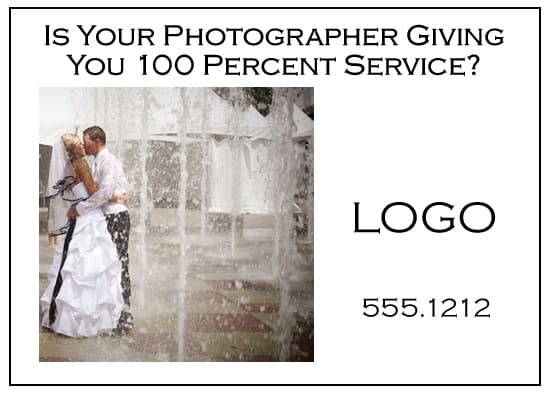If you’ve been in business for any length of time, you’ve created a number of marketing campaigns to reach out to potential customers.
Why did you create them?
If you thought, “to bring in customers” you’re only half right.
Ultimately all marketing is created to bring in new customers. But if you don’t consider the “how” within the campaign itself, you’ll never have the results you’re looking for. Let me explain.

I recently went through a wedding magazine here in my local community. Chances are its not a whole lot different from the one’s in your community. And as I browsed through them one thing clearly jumped out at me.
All of the ads are virtually the same.
Sure, the photo, logo and phone number changed. But the structure of the ads themselves was all the same.
So what makes someone choose one over the other?
An Ad Needs To Say More
As a photographer, I know how easy it is to get caught up in the emotion of your own work. You loved the client, you loved the atmosphere, and the particular image you’ve chosen for your ad really “speaks” to you.
The problem is the potential client doesn’t have that same vantage point. They don’t know the client, they don’t know the details of the image, and they don’t know how well you’ve connected with the image. They just see the one photo in the ad, and base their entire first impression from it.
The problem is their first impression becomes muddled when they see photo after photo, page after page, and they all pretty much begin to look alike. And that’s because business owners don’t take it to the next level, and put into a marketing campaign what truly needs to be there.
The goal of every marketing campaign is to create a new belief, or change an old one.
We buy because somewhere deep inside of us we know we have a “problem”. And the person that comes closest to helping us solve our “problem” is the company that we ultimately will do business with.
Don’t believe me? Think about any product you’ve recently purchased.
Let’s use household cleaners. If you go up and down the aisle at your local store, you know there are dozens of different options. Some are “extra strength”, some are “gentle”, some are “safe for the environment”. When you approach the cleaning aisle, you have a “problem”. You want to buy a cleaning product to use within your home. So you go shopping with a few ideas in mind, and possibly some preferences. Yet just by looking through the available products, you can quickly be swayed to other options. Maybe you’ve never thought about the harmful affects of cleaning products before. Would one that promised to “be safe in the environment your kids live in” make you think twice before you buy? Of course. Their marketing campaign – in this case the title and tag lines on the product itself – is enough to win you over and make you buy. And if you add in a television commercial or magazine ad that explains the same things in more detail, you may bypass looking at the products on the shelves, and go straight into the store with the sole intension of buying the “safe” product.
Okay, that’s cleaners. But does it really work for photography? Of course.
Since I began with an “ad” of a wedding photographer above, lets continue on with that example.
What is a bride looking for when she’s hunting for a wedding photographer?
Some brides may be looking for the perfect photographer because she doesn’t want to relive the horror of having “uncle Bob” shoot her wedding and lose everything like her best friend went through.
Or maybe she’s looking for a great photographer that will fit in with her personality, offer her a high level of customer service, and provide the perfect memories of her very special day.
Brides all have different visions and different wants from their photography. But if they have to choose based on dozens of ads that all look the same, it comes down to a coin toss.
Start the process by making them think. Even a simple question can set you a part from your competitors.

Then go into more detail. You may not be able to get a ton of information into an ad, but why not continue the story on your website? If you’re mailing a postcard, continue the story on the back, and explain why the average photographer doesn’t give you 100 percent of the service they deserve.
The goal is to get them to start questioning how all other photographers do things, and why you’re a little different. Once you get that question into their minds, you’ll quickly move apart from your competition. And book more.










